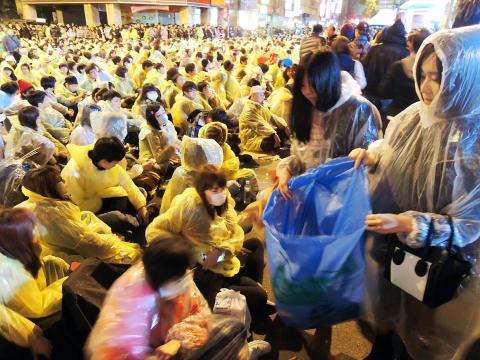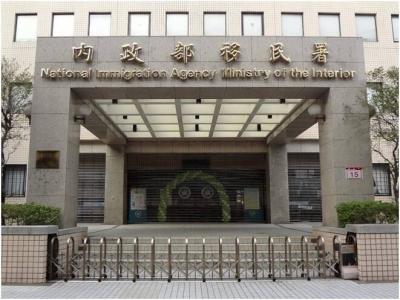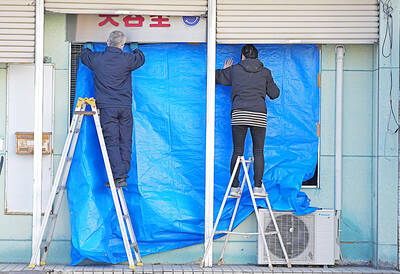Hundreds of students surprised the nation on Tuesday night when they broke off from an overnight sit-in and occupied the legislature in protest against the Chinese Nationalist Party (KMT) caucus’ handling of the cross-strait service trade pact.
After successfully fending off several evacuation attempts by the police and garnering national support over the past five days, the protest, which the media have dubbed the “Sunflower movement” — the largest student movement since the Wild Lily movement in 1990 that propelled legislative reform.
There are skeptics questioning almost everything about the group of young people — from their storming of the legislative compound and drinking beer in the legislative chamber, to their connections with opposition parties and their knowledge about the trade pact.

Photo: Hsieh Wen-hua, Taipei Times
In particular, there have been many questions about the cause and sustainability of the movement.
The students have been responding to these queries on an hourly basis.
In the legislature and the rallies outside the Legislative Yuan compound, students organized into groups to clean graffiti from the walls, recycle trash and maintain order.
Set up like a well-trained army unit, the students were divided into various teams of logistics, communication, patrol and — with help from volunteer physicians and lawyers — a medical team and a legal team were quickly assembled.
That was partly because the leaders of the movement, National Taiwan University graduate student Lin Fei-fan (林飛帆) and National Tsing Hua University student Chen Wei-ting (陳為廷), as well as other members of the core leadership are seasoned veterans in social movements despite their youth.
They gained experience from numerous protests in the past two years, including the one against land seizures at Miaoli County’s Dapu Borough (大埔) and the construction of the Miramar resort in Taitung County, the campaign against media monopolization and the anti-nuclear movement.
Well aware of the nation’s political situation, the students have distanced themselves from political parties and stayed away from the so-called “blue-green struggle.”
Quite contrary to what several local media outlets and the KMT portray, most of the students in those protests have been able to explain their cause clearly and stand firmly for what they believed in.
The “Sunflower movement” is more than an overnight phenomenon and should be interpreted beyond these young people’s discontent with President Ma Ying-jeou’s (馬英九) governance.
It is the cultivation of the students’ effort in the past two years, during which they defied conventional views about the younger generation — that they could not care less about politics and the world they live in — and showed Taiwanese that they do care and they would take action to make the country a better place — any time and anywhere.
If today’s group of young activists have learned from what happened to the “Wild Lily generation,” some of them are more than likely to become the backbone of Taiwanese politics and social movements in the next 10 years.
From what people have seen so far, the new young activists show a deep caring for the nation and for the purity of politics as it was in the early 1990s.

A small number of Taiwanese this year lost their citizenship rights after traveling in China and obtaining a one-time Chinese passport to cross the border into Russia, a source said today. The people signed up through Chinese travel agencies for tours of neighboring Russia with companies claiming they could obtain Russian visas and fast-track border clearance, the source said on condition of anonymity. The travelers were actually issued one-time-use Chinese passports, they said. Taiwanese are prohibited from holding a Chinese passport or household registration. If found to have a Chinese ID, they may lose their resident status under Article 9-1

Taiwanese were praised for their composure after a video filmed by Taiwanese tourists capturing the moment a magnitude 7.5 earthquake struck Japan’s Aomori Prefecture went viral on social media. The video shows a hotel room shaking violently amid Monday’s quake, with objects falling to the ground. Two Taiwanese began filming with their mobile phones, while two others held the sides of a TV to prevent it from falling. When the shaking stopped, the pair calmly took down the TV and laid it flat on a tatami mat, the video shows. The video also captured the group talking about the safety of their companions bathing

PROBLEMATIC APP: Citing more than 1,000 fraud cases, the government is taking the app down for a year, but opposition voices are calling it censorship Chinese Nationalist Party (KMT) Chairwoman Cheng Li-wun (鄭麗文) yesterday decried a government plan to suspend access to Chinese social media platform Xiaohongshu (小紅書) for one year as censorship, while the Presidential Office backed the plan. The Ministry of the Interior on Thursday cited security risks and accusations that the Instagram-like app, known as Rednote in English, had figured in more than 1,700 fraud cases since last year. The company, which has about 3 million users in Taiwan, has not yet responded to requests for comment. “Many people online are already asking ‘How to climb over the firewall to access Xiaohongshu,’” Cheng posted on

A classified Pentagon-produced, multiyear assessment — the Overmatch brief — highlighted unreported Chinese capabilities to destroy US military assets and identified US supply chain choke points, painting a disturbing picture of waning US military might, a New York Times editorial published on Monday said. US Secretary of Defense Pete Hegseth’s comments in November last year that “we lose every time” in Pentagon-conducted war games pitting the US against China further highlighted the uncertainty about the US’ capability to intervene in the event of a Chinese invasion of Taiwan. “It shows the Pentagon’s overreliance on expensive, vulnerable weapons as adversaries field cheap, technologically